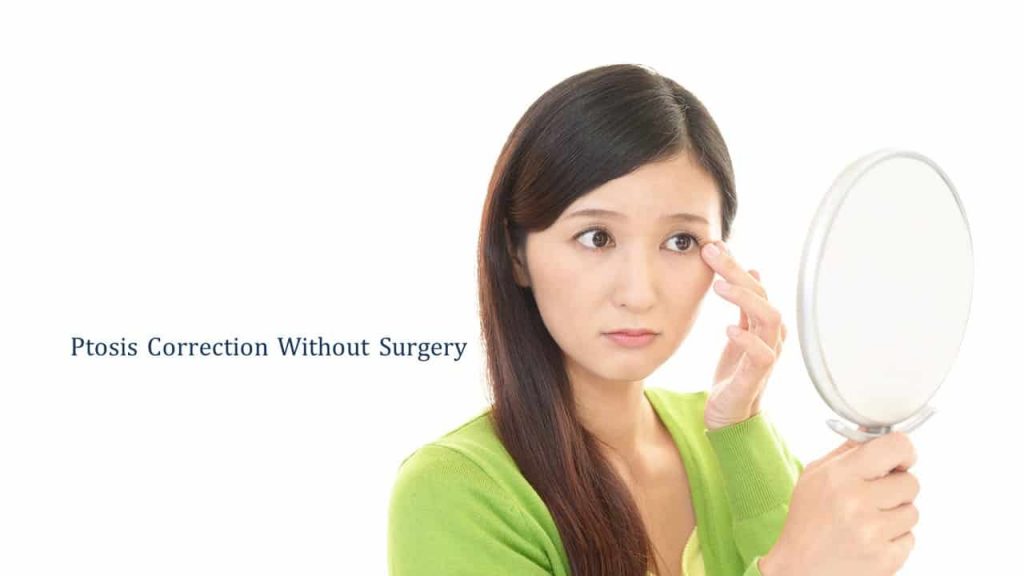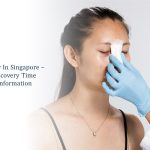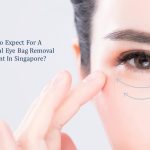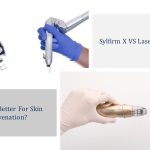“Eyes are the windows to the soul.” To keep projecting your beautiful soul, you need to keep the eyes wide open. The eyelids are the gates to your windows that keep them sufficiently open. These gates lose their functionality at the hands of ptosis. To get back the original tensile strength of your eyelids, you ought to go for ptosis correction.
Now the question arises “what is ptosis?” “How can it be corrected and why do you need to correct it?” The following article discusses the possible treatment options for patients suffering from ptosis. Ptosis can be corrected with non-surgical and surgical approaches.
What Is Ptosis?
Ptosis is a condition where the upper eyelids appear saggy and droopy, therefore, it is commonly known as droopy eyelids. It is a common finding in the elderly, but it can also happen to other individuals regardless of age. It is usually first identified as an aesthetic concern in the majority of the cases, however, it may hamper day-to-day activities if severity increases.
How Do I Know If I Have Ptosis?
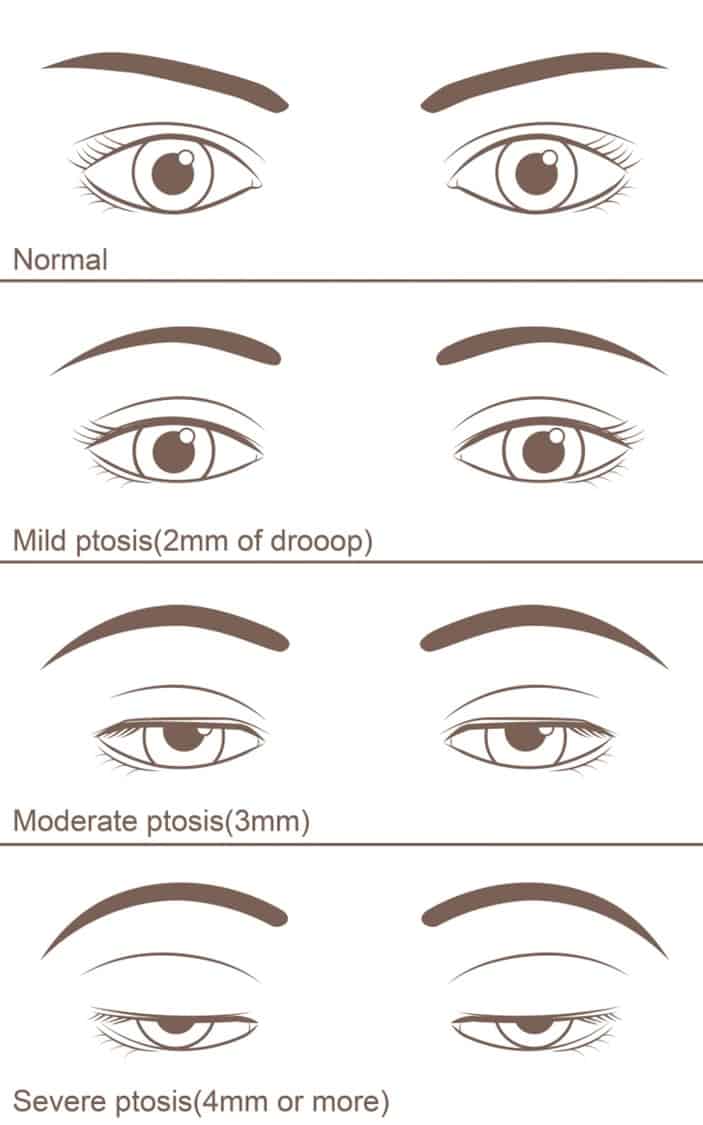 Patients with droopy eyelids present with the following features:
Patients with droopy eyelids present with the following features:
- Drooping, sagging eyelids (upper)
- The skin around the eyes is wrinkled
- A puffy appearance of upper and lower eyelids (due to fatty tissue deposition)
- Watery eyes
- Dry eyes
- A tired appearance of the patient
Complications And Dangers Of Ptosis
Poor eyesight resulting from severe ptosis can lead to the following complications in the senile members of the society:
- Frequent falling
- Tilting of the head backward (for improving vision) may lead to postural imbalances
- Dryness of the eyes
- Extra effort for opening eyes is tiresome for old adults
Types Of Droopy Eyelids
Ptosis may be present at birth i.e. congenital ptosis or may be acquired later in life i.e. acquired ptosis. The disorder is further classified into different subclasses based on their underlying cause:
- Aponeurotic (most prevalent in old adults)
- Neurogenic (disruption of muscular innervation)
- Myogenic (issues in levator muscle of the eye)
- Traumatic ptosis
- Mechanical ptosis (issues of skin such as a tumor or scarring)
Non-Surgical Ptosis Treatment
Ptosis correction can be indicated for different concerns. Some patients want to get it done for aesthetic reasons while some want to get a clearer view of the world and choose to correct them for functional reasons. Correction can be achieved surgically and non-surgically. The choice of treatment modality depends on the severity of the ptosis condition.
Non-surgical treatment is possible and is recommended for the following categories of patients:
Mild And Moderate Droopy Condition
People suffering from moderate ptosis can consider non-surgical correction. This category includes patients who want correction merely for aesthetic reasons and do not feel any hindrance to normal functioning.
In mild ptosis, the distance between the upper lid margin and corneal light reflex (MRD) is 2mm while for moderate cases is 3mm.
For Those Who Fear Surgery
Non-surgical correction of ptosis is the only option left for those who suffer from severe drooping yet fear surgery. For such patients, the correction is limited. It was found in a study that old people are fearful of getting surgery and undergoing general anaesthesia.
Types Of Treatment Options
The main aim of the procedure is to elevate the upper eyelids. Those interested in getting a non-surgical ptosis correction have the following options to regain younger and fresher-looking eyes.
 Brow Lift With Botox
Brow Lift With Botox
This anti-wrinkle procedure involves injecting botulinum toxin (Botox) injection into the eyelids to elevate eyebrows. According to a study, a significant temporal brow lift was seen with the use of botox injections.
Botox injection is considered an efficient way of reshaping the eyelids, especially in ptosis patients, a study suggests. The toxin is usually injected into the upper eyebrow region and the region between eyebrows (i.e. glabella).
Thermage Eye Lift
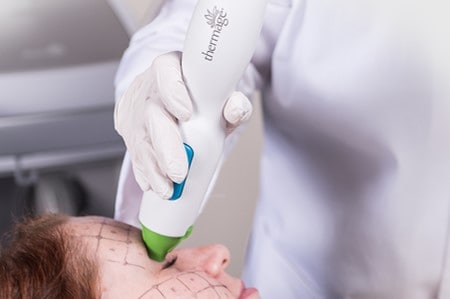 Thermage CPT is a non-invasive procedure that involves correcting saggy eye skin by the use of radiofrequency. The very treatment is effective in reviving loose skin, especially around the eye area. Old patients with mild to moderate ptosis can get the most benefit from it.
Thermage CPT is a non-invasive procedure that involves correcting saggy eye skin by the use of radiofrequency. The very treatment is effective in reviving loose skin, especially around the eye area. Old patients with mild to moderate ptosis can get the most benefit from it.
According to a 2020 study, the latest techniques in Thermage are pretty effective in relieving ptosis. The procedure is more effective, faster, and less painful. As per a randomized controlled trial use of radiofrequency was found to be effective in lifting facial skin that had sagged due to aging.
Ptosis Crutch
This non-surgical procedure can be adopted by glasses wearers. In this particular step, an attachment is added to the frames of your glasses that act as crutches to your eyelids. The attachments can be adjusted and may be added to one or both sides of the frames. They work best with metal frames. Research suggests that it is an effective procedure for treating ptosis.
Benefits Of Non-Surgical Over Surgical Procedures
The major benefits of non-surgical ptosis correction over surgical treatment are:
- No discomfort or pain of the surgery is experienced
- No adverse effects of anaesthesia are faced
- No extra skin (fat and muscle) removed
- The healing time is quicker as compared to surgery
- Is affordable (as compared to surgery)
- There are no associated risks of surgical procedure (infection, wound dehiscence)
- Gets you results quicker and with little to no downtime
Limitations Of Non-Surgical Procedures
The treatment is not recommended for :
- Patients with severe ptosis i.e MRD greater than 4mm
- People aged below 18 years of age
- Pregnant women
- Nursing mothers
- Patients taking blood thinner medicines
Surgery For Severe Cases: Blepharoplasty
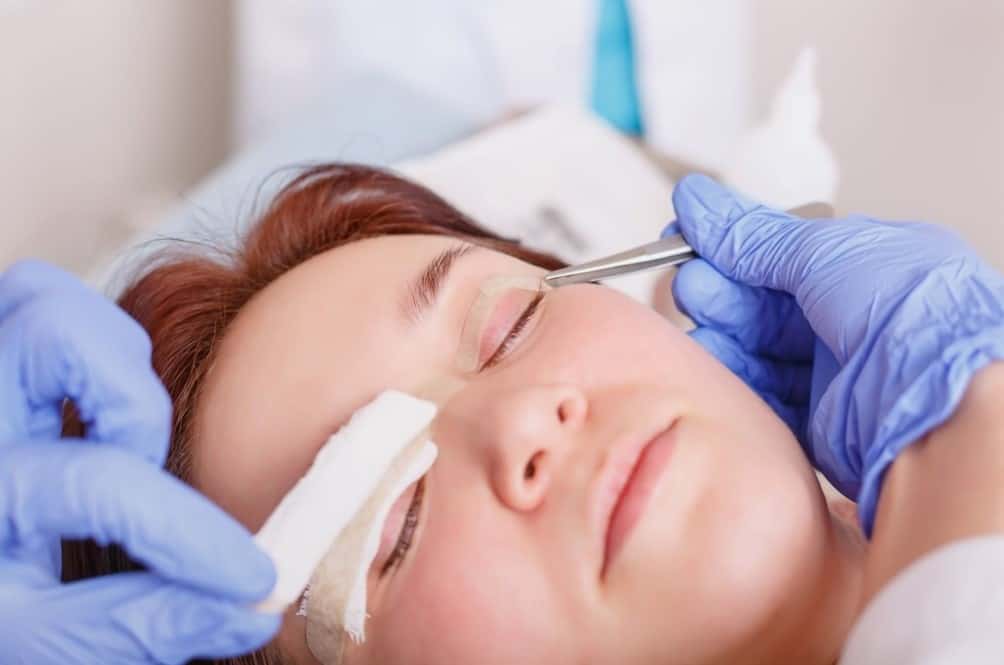 Injections of toxin and fillers can be a beneficial step for managing moderate cases of ptosis. However, for severe cases where droopy eyelids interfere with eyesight, surgical intervention is recommended.
Injections of toxin and fillers can be a beneficial step for managing moderate cases of ptosis. However, for severe cases where droopy eyelids interfere with eyesight, surgical intervention is recommended.
The surgical procedure of lifting eyelids is known as blepharoplasty. The most common surgical procedures of surgery include:
Suture Ptosis Eyelid Correction Technique
This procedure involves stitching eyelid tissue to readjust the position of eyelids. No incision is given, only stitching is done and is good for mild ptosis.
Incisional Ptosis Eyelid Correction Technique
A crease is created in the eyelid muscle by giving an incision. Unnecessary muscles of the eyelid (fat and skin) are removed along with the incision. Is a good option for mild to severe ptosis.
Frontalis Suspension Technique
Weak eyelids pose a problem in treating ptosis surgically. When treating congenital ptosis, the frontalis suspension technique is employed. In this process, the eyelid is sutured to the brow with a sling material. It utilizes the power of the frontalis muscle to elevate eyelids.
Where Can I Get The Most Suitable Treatment?
If you are baffled at choosing the ideal type of treatment modality, we suggest you visit Dream Plastic Surgery Singapore. You can speak to the extremely professional and highly trained plastic surgeons who shall get you out of this fix. All your questions will be well-answered and all the concerns addressed in detail.
Treating Ptosis (Droopy Eyelids)
Ptosis or droopy eyelids is a condition that is characterized by drooping and sagging of the upper eyelids. The wrinkled eye skin imparts an ugly, tired, and older look. Patients with ptosis experience aesthetic issues when the disease is in mild to moderate form. Severe forms of ptosis lead to functional problems such as poor eyesight leading to frequent falls. Patients can get ptosis correction done surgically. However, there are some non-surgical alternatives available too.
Filler injections such as hyaluronic acid and Plasma-rich protein can help correct the sagged and wrinkled eyebrow skin. Injecting botulinum toxin into the eyelids and the middle region (between eyebrows) is shown to be efficacious. Other non-surgical procedures include Thermage eye lift procedures where radiofrequency and lasers are used to elevate eyelids. People who wear glasses can get a simpler solution i.e. eyelid crutches. Small attachments are added to the glasses frame that acts as crutches.
About Dream Aesthetics and Plastic Surgery
Bespoke surgical for cosmetic or medical reasons is what Dream covers to bring out the beauty in every individual. Going beyond the aesthetics and working on physical anomalies are what we value the most in leading our patients to cherish self-improvement and confident lifestyles.
Derived from Associate Professor Vincent Yeow’s long-standing experience performing plastic surgery in Singapore, our treatment plans deliver physical remodelling in our patients’ favour. One of the notable remodellings is droopy eyelid correction. The ptosis surgery used for treatment eventually fixes drooping eyelids, improves vision and enhances appearance.
Most importantly, as a trustworthy plastic surgery and aesthetic clinic, we treasure positive and natural outcomes for each individual. We will ensure to deliver the beauty refinement of your dream without compromising your safety and privacy.

